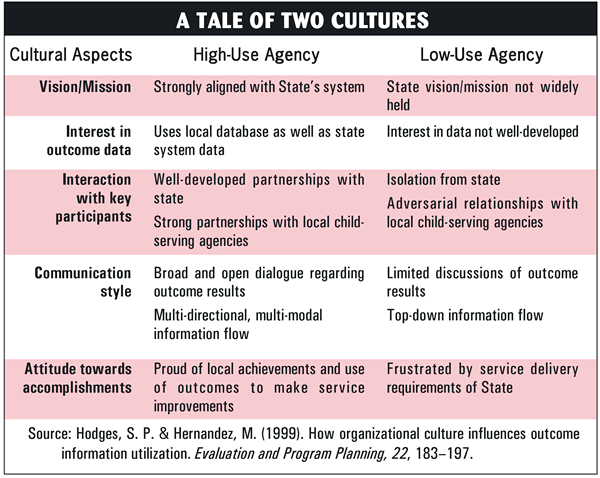 |
 |
 |
©
2004 Jordan Institute
for Families

Vol.
9, No. 4
July 2004
Agency Culture: A Big Influence on the Use of Outcome Data
Why do some agencies make active use of outcome information in their decision making, while others do not? Most of us would probably say it has something to do with resources. Especially North Carolina, where many of the child welfare agencies that seem furthest along in this area are in larger, wealthier counties, this seems like a reasonable answer.
Reasonable, perhaps, but not altogether correct, according to a recent study. Although technical, financial, and personnel resources are required to use outcome information in decision making, the single most important ingredient may not be money, but agency culture.
The
Study
In 1999 researchers Hodges and Hernandez explored the relationship between
organizational culture and the use of outcome information in four child-serving
mental health agencies in Texas. All four agencies received training in
the analysis and use of outcome information, periodic outcome information
reports, and support from a state agency. However, two agencies were “high”
users of outcome information and two were “low” users of outcome
information.
When they looked at the culture in high-use agencies, researchers found:
- Long-standing partnerships with state-level staff and local child-serving agencies
- Problem-solving that focused on processes, not individuals. Data was viewed as feedback that enabled staff to see what worked and when to make corrections
- Appreciation of data. Staff could give examples of how outcome data had improved their responsiveness to families
- Communication that was bottom-up and top-down, and that supported team work and shared responsibility for outcomes
- Broad sharing of outcomes information throughout the agency
- A willingness to take calculated risks based on outcome data. This allowed agencies to pursue innovative approaches for reaching performance goals
By contrast, researchers found low-use agencies were characterized by:
- A lack of partnerships at the state and local levels. Agencies were concerned with their autonomy and independence
- Disinterest in outcome information among direct service staff. Data was seen as the province and responsibility of managers and administrators
- Communication about outcomes was top-down and minimal
- High staff turnover
- A sense that serving children was overwhelming
The sidebar below highlights the cultural differences between two of the four agencies analyzed by the study.

Connection to Practice
When thinking about this study, readers should not focus on the specific
traits discussed: Hodges and Hernandez did not find a cause and effect
link between specific cultural characteristics and an agency’s ability
to use outcome information.
Instead, readers should focus on the central role played by organizational culture. All of the agencies in this study had access to outcome information and the training and support needed to work with it. The defining difference was that in some of the agencies the organizational culture supported self-evaluation and the use of data. In the others it did not.
Thus, if an agency is serious about using data it should look first at whether its vision, mission, and values—as well as the training its workers receive—all support the idea that outcomes data can play a key role in creating better results for children and families.